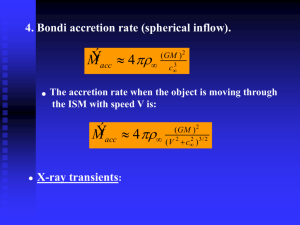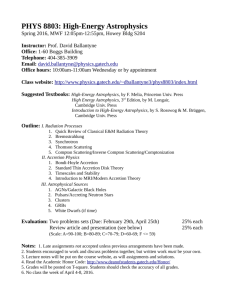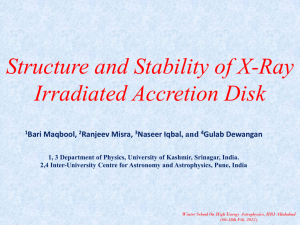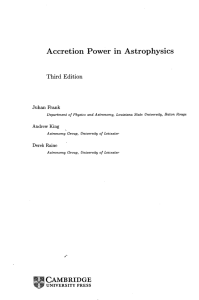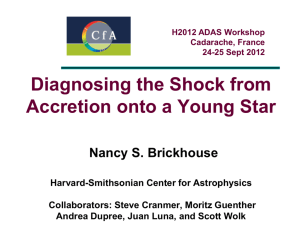munich-obs-smith130906
advertisement
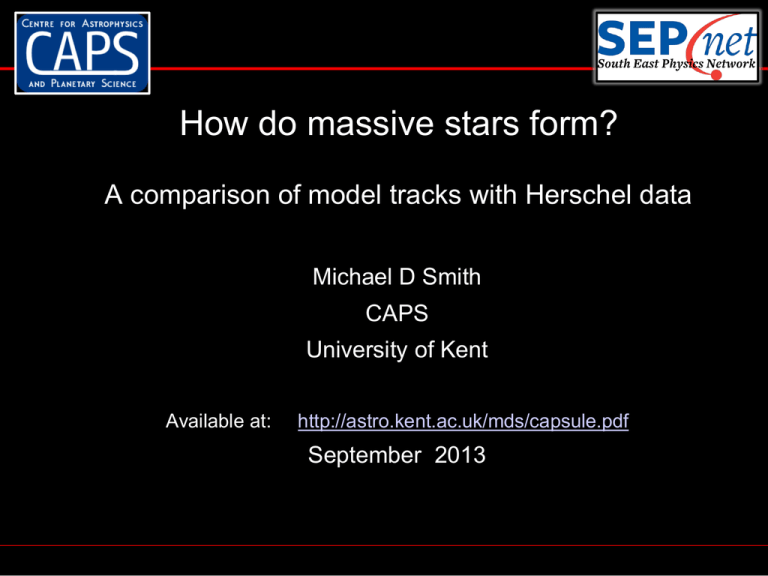
How do massive stars form? A comparison of model tracks with Herschel data Michael D Smith CAPS University of Kent Available at: http://astro.kent.ac.uk/mds/capsule.pdf September 2013 Late stage: Rosette in optical AFGL 2591 Rosette Nebula, Travis Rector, KPNO Li et al 2008 ApJL 679, L101 Early emerging: near-infrared, with outflows Near-Infrared Interferometry: Preibisch, Weigelt et al. S140 IRS Mon R2 3 AFGL 2591 S140 IRS 1 R Mon IRAS 23151+5912 K3-50 A Numerical telescope: K-band imaging reflected shock AFGL 2591 total Adapted from Gorti & Hollenbach 2002 ● Approach 1: HMCs to UCHii to Hii ● 6 Approach 2: IRDCs, ALMA, to Herschel cool cores Peretto et al 2013, 555, A112 IRDCs: initial states imprinted - SDC335 Accelerated accretion a) Mid-infrared Spitzer composite image (red: 8 μm; green: 4.5 μm; blue: 3.6 μm) b) ALMA-only image of the N2H+(1−0) integrated intensity, c) ALMA N2H+(1−0) velocity field ● 7 Approach 3: two stage stitch-up Molinari et al 2008 noted: lack of diagnostic tools. Stage 1: Accretion phase Stage 2: Clean up, cluster forms + sweep out Early protostar: Accelerated accretion model (Mckee & Tan 2003) Clump mass and final star mass simply related): Accelerated accretion ● 8 Approach 3: two stage stitch-up Molinari et al 2008 tracks from SED to mm dust masses Diagnostic tools: Lbol-Mclump-Tbol Accelerated accretion Mclump/Msolar ● 9 Alternative evolutions Dark cloud fragments into cores/envelopes. Envelope accretion: from fixed bound envelope, bursts etc Global collapse. Accretion evolutions: from clumps, competitive, turbulent. Cores and protostars grow simultaneously Mergers, harrassment, cannabolism, disintegration ● 10 Issues for Massive Stars Most massive? Radiation feedback problem Environment? Cluster-star evolutions? Efficiency problem. Global collapse or fragmentation? IMF: Feedback - radiation and outflow phases? EUV problem Separate accretion luminosity from Interior luminosity? Bursts? Luminosity problem Two phases; accretion followed by clean-up? Dual evolution? ● 11 Recent Simulations Krumholz et al. 2007 , 2009 ; Peters et al. 2010a , 2011 ; Kuiper et al. 2010a , 2011 , 2012 ; Cunningham et al. 2011 ; Dale & Bonnell 2011 Kuiper & Yorke 2013: 2D RHD, core only: spherical solid-body rotation + protostellar structure. Conclusion: diverse, depends on disk formation, bloating and feedback coordination. ● 12 Objective: Model for Massive Stars Piece together evolutionary algorithms for the protostellar structure, the environment, the inflow and the radiation feedback. The framework requires the accretion rate from the clump to be specified. We investigate constant, decelerating and accelerating accretion rate scenarios. We consider both hot and cold accretion, identified with spherical free-fall and disk accretion, respectively. ● 13 Objective: Model for Massive Stars Piece together evolutionary algorithms for the protostellar structure, the environment, the inflow and the radiation feedback. The framework requires the accretion rate from the clump to be specified. We investigate constant, decelerating and accelerating accretion rate scenarios. We consider both hot and cold accretion, identified with spherical free-fall and disk accretion, respectively. ● 14 Hosokawa, Omukai, Yorke 2009, 2010 Kuiper & Yorke 2013 ApJ 772 Cold or Hot Accretion? ● 15 The protostar: radius Stellar radius as mass accumulates (I) adiabatic, (II) swelling/bloating, (III) Kelvin–Helmholtz contraction, and (IV) main sequence Hot accretion Cold accretion ● 16 The protostar: luminosity Origin Luminosity as mass accumulates (cold) ● 17 The protostar: adaption Assumed mass accretion rates + interpolation scheme ● 18 The Low-Mass Scheme: Construction Clump ● ● Envelope Bipolar Outflow ● Evolution: ● systematic and simultaneous • Protostar L(Bolometric) • Jet L(Shock) • Outflow Momentum (Thrust) • Clump/Envelope • Class • Disk Accretion Disk Jets ● mass conservation ● prescribed accretion rate ● bifurcation coefficient ● jet speed ~ escape speed Mass Temperature Infrared excess Protostars The Capsule Scheme: Construction Radio: H II region ● Clump Lyman Flux Envelope Radiative Flux Accretion Disc Bipolar Outflow H2 shocks Protostar Jets thermal radio jets Capsule Flow Chart ● 21 The clump mass, isotherms + Herschel data Origin Luminosity as clump mass declines Constant slow accretion Accelerated accretion ( Accelerated accretion Power Law deceleration Data: Elia et al 2010), Hi-GAL (Data: Molinari et al 2008) ● 22 Bolometric Temperature Origin Distance dotted line = accelerated accretion Herschel: <20K: 0.463 <30K: 0.832 <50K: 0.950 ● 23 Bolometric Temperature Clump = cluster x 2 Clump = cluster x 6 ● 24 Lbol-Mclump-Tbol results We find that accelerated accretion is not favoured on the basis of the often-used diagnostic diagram which correlates the bolometric luminosity and clump mass. Instead, source counts as a function of the bolometric temperature can distinguish the accretion mode. Specifically, accelerated accretion yields a relatively high number of low-temperature objects. On this basis, we demonstrate that evolutionary tracks to fit Herschel Space Telescope data require the generated stars to be three to four times less massive than in previous interpretations. This is consistent with star formation efficiencies of 10-20% ● 25 The clump mass, isotherms + Herschel data Or Luminosity as clump mass declines: massive clumps ● 26 GHz data) Sanchez-Monge et al., 2013, A&A 550, A21 The Lyman Flux (ATCA 18 Orig Accelerated accretion Lbol /Lsun Bolometric Luminosity ● 27 The Lyman Flux Origin D COLD accretion + Hot Spots (75%, 5% area) Distributed accretion Accretion hotspots Orig Constant accretion rate ● 28 The Lyman Flux: summary Neither spherical nor disk accretion can explain the high radio luminosities of many protostars. Nevertheless, we discover a solution in which the extreme ultraviolet flux needed to explain the radio emission is produced if the accretion flow is via free-fall on to hot spots covering less than 20% of the surface area. Moreover, the protostar must be compact, and so has formed through cold accretion. This suggest that massive stars form via gas accretion through disks which, in the phase before the star bloats, download their mass via magnetic flux tubes on to the protostar. ● 29 Jet speed = keplerian speed Or Different constant accretion rates……….. ● 30 What next? ● Disk – planet formation ● Binary formation, mass transfer etc ● Mass outflows v. radiation feedback ● Feedback routes ● Outbursts ● Thermal radio jets ● ??? ● Michael D. Smith - Accretion ● 31 Thanks For Listening! ANY QUESTIONS? Low-Mass Protostellar Tracks ● X-Axis: Luminosity ● Y-Axis: Jet Power ● Tracks/Arrows: the scheme ● Diagonal line: ● ● Class 0/I border Data: ISO FIR + NIR (Stanke) ● Above: Class 0 ● Under: Class 1 Disk evolution ● Column density as function of radius and time: (r,t) ● Assume accretion rate from envelope ● Assume entire star (+ jets) is supplied through disc ● Angular momentum transport: ● - turbulent viscosity: `alpha’ prescription ● - tidal torques: Toomre Q parameterisation ● Class 0 stage: very abrupt evolution?? Test…… ● …to create a One Solar Mass star ● Michael D. Smith - Accretion ● 34 The envelope-disc connection; slow inflow ● ● ● Peak accretion at 100,000 yr Acc rate 3.5 x 10-6 Msun/yr Viscosity alpha = 0.1 ● ● ● 50,000 yr: blue ● 500,000 yr: green 2,000,000 yr: red Michael D. Smith - Accretion ● 35 The envelope-disc connection; slow inflow; low alpha ● ● ● Peak accretion at 200,000 yr Acc rate 3.5 x 10-6 Msun/yr Viscosity alpha = 0.01 ● 50,000 yr: blue ● 500,000 yr: green 2,000,000 yr: red ● ● Michael D. Smith - Accretion ● 36
